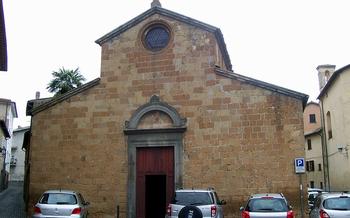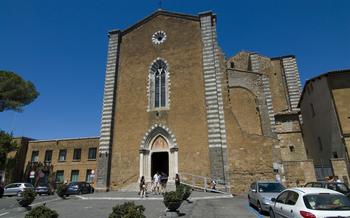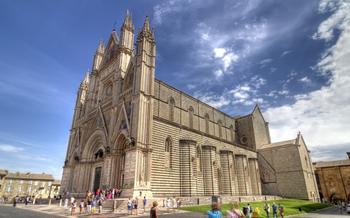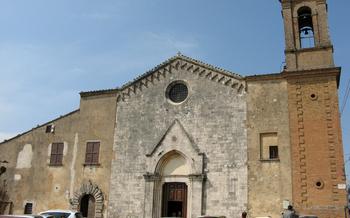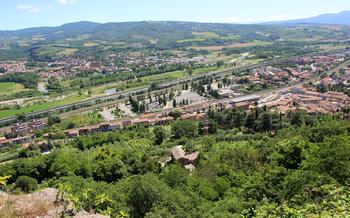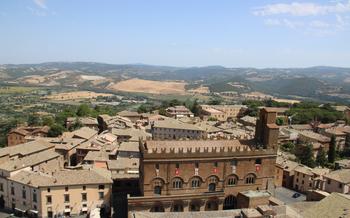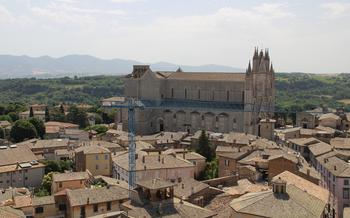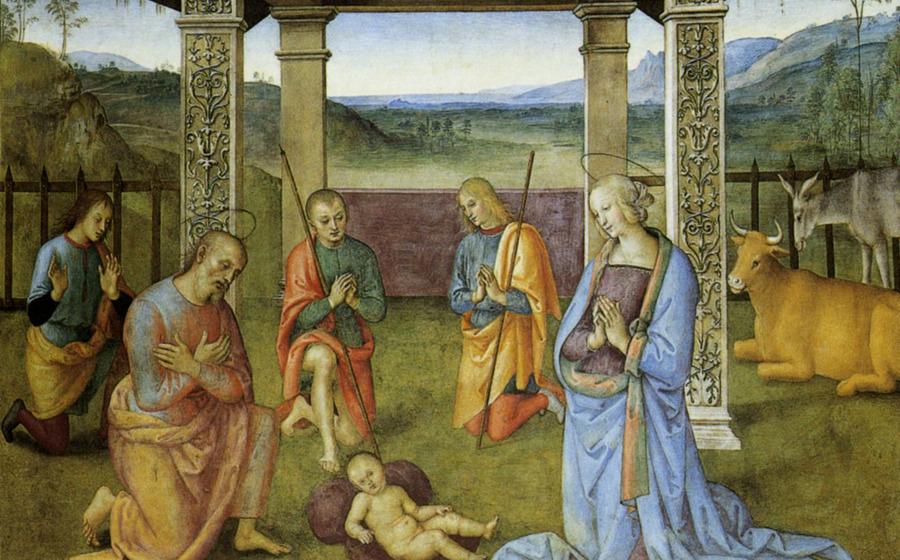
Chiesa di San Pietro
- Introduction
- Importance of the Church
- History of the Chiesa di San Pietro
- Exterior of the Church
- Interior of the Church
- Frescoes by Fra Angelico
- Tabernacle by Arnolfo di Cambio
- Cappella del Corporale
- Cappella del Miracolo della Madonna
- Crypt and Relics
- Significance in the Religious Life of Orvieto
- Practical Information for Visitors
- Nearby Attractions
- Suggested Itineraries
- Insider Tip
Introduction
Orvieto, an enchanting hilltop town in Umbria, is renowned for its rich historical, artistic, and spiritual heritage. Nestled amidst picturesque landscapes and ancient Etruscan ruins, Orvieto boasts an array of architectural wonders, including the magnificent Chiesa di San Pietro, which stands as a testament to the city's religious and cultural significance. Located in the heart of Orvieto's historic center, the church occupies a prominent position, drawing visitors and pilgrims alike to its sacred spaces and awe-inspiring beauty.
Importance of the Church
The Chiesa di San Pietro holds immense religious significance as one of the most important churches in Orvieto. It is dedicated to Saint Peter, the first pope and a central figure in Christianity. The church serves as a focal point for religious ceremonies, processions, and devotions, deeply ingrained in the spiritual life of the local community. Throughout the centuries, the Chiesa di San Pietro has played a pivotal role in shaping Orvieto's cultural landscape, attracting pilgrims and visitors from across the region and beyond.
History of the Chiesa di San Pietro
The Chiesa di San Pietro was constructed in the late 13th century, during a period of significant growth and prosperity for the city of Orvieto. The exact date of its foundation is uncertain, but it is believed to have been completed around 1290. The church was built in the Romanesque-Gothic style, which was popular in Italy at the time. This style is characterized by its use of round arches, ribbed vaults, and pointed windows. The church was designed by and built under the supervision of the architect Lorenzo Maitani, who is also known for his work on the Orvieto Cathedral. San Pietro played a significant role in medieval Orvieto, serving as a place of worship, a meeting place for the community, and a symbol of the city's religious and cultural heritage.
Exterior of the Church
The facade of the Chiesa di San Pietro is a splendid blend of Gothic and Renaissance styles. The lower section, dating back to the 13th century, is characterized by a simple yet elegant design, with a series of blind arches and a central portal adorned with intricate carvings. The upper section, added in the 15th century, features a more elaborate ornamentation, with a large rose window flanked by niches containing statues of saints.
The bell tower, which soars high above the church and the surrounding cityscape, is a masterpiece of Gothic architecture. Constructed in the 14th century, it showcases a graceful octagonal shape and is adorned with elegant pinnacles and tracery. The tower is a testament to the skill and artistry of medieval builders and offers breathtaking views of Orvieto and the surrounding countryside from its top.
The exterior of the church is further embellished with a variety of sculptures and reliefs, which depict religious scenes and figures. These artworks, created by talented local artisans, add to the richness and beauty of the church's exterior, making it a true treasure trove of medieval art and architecture.
Interior of the Church
The interior of the Chiesa di San Pietro unfolds in a harmonious and elegant space, characterized by its ample proportions and the interplay of light filtering through the stained-glass windows. The church features a single nave, flanked by two lateral aisles that extend along its length, separated by sturdy pillars. The nave is covered by a vaulted ceiling, adorned with intricate frescoes and decorative elements, adding depth and visual interest to the interior.
The nave houses a series of side chapels, each dedicated to a specific saint or religious figure and often adorned with beautiful artworks, frescoes, and sculptural decorations. These chapels act as devotional spaces, offering visitors a chance for quiet reflection and prayer. Among the notable frescoes in the church is the depiction of the "Last Judgment" above the main altar, a striking and awe-inspiring masterpiece worth contemplating.
Frescoes by Fra Angelico
Fra Angelico, a Dominican friar and renowned Renaissance artist, left an indelible mark on the Chiesa di San Pietro with his breathtaking frescoes.
-
Life and Works of Fra Angelico: Fra Angelico, born Guido di Pietro, was a pivotal figure in the Early Renaissance, known for his exquisite frescoes and panel paintings. His works exuded a profound spirituality and meticulous attention to detail, earning him the title "Angelic Painter."
-
Location of the Frescoes in the Church: Within the Chiesa di San Pietro, Fra Angelico's frescoes adorn the Cappella di San Brizio, a small chapel located off the right transept. This intimate space becomes a canvas for his artistic genius.
-
Artistic Significance of the Frescoes: The frescoes depict scenes from the life of Christ, including the Annunciation, the Last Judgment, and the Resurrection. Fra Angelico's mastery of perspective, vibrant colors, and lifelike figures creates a sense of depth and realism that captivates viewers. His ability to convey spiritual themes through his art elevates these frescoes beyond mere decoration, making them masterpieces of the Renaissance period.
Tabernacle by Arnolfo di Cambio
Arnolfo di Cambio, a renowned Italian sculptor and architect, left an indelible mark on the artistic heritage of Orvieto with his creation of the tabernacle, a masterpiece nestled within the Chiesa di San Pietro. Born in Colle di Val d'Elsa around 1240, Arnolfo di Cambio is celebrated for his contributions to the Gothic style in Italy. His works can be admired in various cities, including Florence, Rome, and, of course, Orvieto.
The tabernacle, crafted from gleaming white marble, stands as a testament to Arnolfo's exceptional artistry. Its intricate carvings, intricate details, and graceful lines showcase his mastery of the craft. Positioned prominently in the church, the tabernacle serves as a focal point, drawing the attention of visitors with its captivating beauty.
Historical records indicate that the tabernacle was commissioned by Pope Urban IV in 1264, during his papacy in Orvieto. The pope entrusted Arnolfo di Cambio with the task of creating a worthy vessel to house the consecrated Host, the sacred bread used in the Catholic Eucharist. Arnolfo meticulously worked on the tabernacle for several years, pouring his heart and soul into its creation.
The result is a stunning masterpiece that blends Gothic and Classical elements. The tabernacle's rectangular shape is adorned with a series of cusped arches, a characteristic feature of Gothic architecture. Within these arches, Arnolfo sculpted delicate tracery and intricate pinnacles, lending an air of lightness and elegance to the structure.
At the center of the tabernacle, the artist placed a ciborium, a container used to hold the consecrated Host. The ciborium, supported by slender columns, is crowned with a miniature Gothic spire, echoing the architectural motifs of the surrounding arches.
Arnolfo's attention to detail is evident in every aspect of the tabernacle. The marble surface is meticulously carved with a variety of decorative motifs, including floral patterns, geometric designs, and human figures. These intricate carvings add depth and texture to the work, making it a feast for the eyes.
The tabernacle by Arnolfo di Cambio remains an artistic treasure of the Chiesa di San Pietro, a testament to the skill and devotion of one of Italy's most celebrated sculptors. Its historical and artistic significance make it a must-see for anyone visiting Orvieto, offering a glimpse into the rich artistic heritage of this captivating city.
Cappella del Corporale
The Cappella del Corporale is a sacred space within the Chiesa di San Pietro that holds immense religious significance for the city of Orvieto. It is dedicated to commemorating a miraculous event known as the "Miracle of the Corporal."
In 1263, during a religious procession, a priest accidentally spilled a few drops of consecrated wine onto a corporal, a cloth used to cover the chalice during the Eucharist. To the astonishment of all, the wine left an indelible stain on the fabric, which defied all attempts to remove it. This extraordinary occurrence was interpreted as a divine sign, and the bloodstained corporal became a revered relic.
The Cappella del Corporale was constructed in the 14th century to enshrine and safeguard this sacred artifact. It is a small, yet ornate chapel located to the left of the main altar. The interior exudes an aura of reverence and devotion, with intricate frescoes depicting scenes from the life of Christ and the Virgin Mary adorning the walls.
At the heart of the chapel lies the reliquary, a magnificent tabernacle crafted from gold and silver. Within it, the bloodstained corporal is preserved, encased in a crystal vessel. Pilgrims from far and wide flock to the chapel to pay homage to this miraculous relic, which continues to inspire awe and devotion among believers.
The Cappella del Corporale serves as a testament to the profound faith and religious traditions that have shaped the history and identity of Orvieto. It is a place where visitors can immerse themselves in the spiritual significance of this sacred relic and reflect on the enduring power of divine miracles.
Cappella del Miracolo della Madonna
The Cappella del Miracolo della Madonna (Chapel of the Miracle of the Madonna) is one of the most significant chapels in the Chiesa di San Pietro, drawing pilgrims and visitors alike with its poignant tale of divine intervention. According to legend, in the 13th century, a young woman from Orvieto was unjustly accused of a crime and sentenced to death. As she was being led to her execution, she stopped to pray before an image of the Madonna enshrined in the church. Miraculously, the Madonna's eyes began to shed tears, a sign of her compassion and intervention. The woman was subsequently exonerated, and the chapel was built in gratitude for this miraculous event.
Inside the chapel, visitors can witness the beautifully preserved 14th-century frescoes depicting the miraculous story. The walls are adorned with vivid scenes of the young woman's trial, her prayer before the Madonna, and the miraculous shedding of tears. These artworks serve as a testament to the enduring faith and devotion of the people of Orvieto, who still revere the Madonna as their protector and guide.
Crypt and Relics
The Chiesa di San Pietro is home to a fascinating crypt, discovered during restoration work in the 19th century. This underground chamber is a testament to the church's rich history and religious significance. Visitors can descend into the crypt through a narrow staircase, embarking on a journey through time and spirituality.
The crypt is an atmospheric space, its walls lined with ancient stonework and adorned with evocative frescoes. It is believed to date back to the early Christian period, serving as a place of burial and veneration for the faithful. Over the centuries, numerous relics associated with the church have been interred within the crypt, creating a sacred and reverent atmosphere.
Among the relics on display are the remains of several saints and martyrs, as well as fragments of sacred objects and vestments. These relics hold immense historical and religious value, attracting pilgrims and visitors from far and wide. The crypt is a poignant reminder of the deep-rooted Christian traditions that have shaped Orvieto's identity throughout the ages.
For those seeking a deeper connection to the spiritual heritage of Orvieto, a visit to the crypt of the Chiesa di San Pietro is a must. It is a place where history, faith, and devotion intertwine, offering a glimpse into the enduring legacy of this remarkable church.
Significance in the Religious Life of Orvieto
The Chiesa di San Pietro holds a profound significance in the religious life of Orvieto. Throughout history, it has played a pivotal role in various religious ceremonies and celebrations.
The church is dedicated to the patron saint of Orvieto, Saint Peter the Apostle, revered for his unwavering faith and leadership of the early Christian church. Local devotion to Saint Peter is deeply ingrained in the city's religious traditions. During his feast day on June 29th, grand processions and festivities take place, honoring the saint and his enduring legacy. The Chiesa di San Pietro serves as the focal point of these celebrations, attracting pilgrims and locals alike.
Beyond its patron saint, the church is inextricably linked to a miraculous event known as the Eucharistic miracle of Orvieto. According to legend, in the 13th century, a doubting priest witnessed the consecrated host miraculously bleeding during Mass. This extraordinary occurrence led to the construction of the Cappella del Corporale within the church, dedicated to preserving the relic of the bloodstained corporal.
To this day, the Chiesa di San Pietro remains a vital center of worship and devotion for the people of Orvieto. Regular masses, special services, and religious observances are held within its walls, fostering a sense of community and spiritual connection among the faithful. Its enduring significance as a sacred space continues to shape the religious fabric of Orvieto, making it a cherished and revered landmark in the city's spiritual landscape.
Practical Information for Visitors
The Chiesa di San Pietro is open to the public from 8:30 am to 12:30 pm and from 3:30 pm to 6:30 pm daily. Admission is free of charge, allowing visitors to explore the church's stunning interior and admire its artistic treasures without any financial barriers.
For those seeking a more in-depth understanding of the church's history and significance, guided tours are available upon request. These tours, led by knowledgeable and passionate local guides, provide visitors with a deeper dive into the church's architecture, artwork, and religious importance. Booking a guided tour in advance is recommended, especially during peak tourist seasons, to secure a spot and avoid disappointment.
When visiting the Chiesa di San Pietro, it's important to be respectful of the sacred nature of the site. Visitors should dress appropriately, avoiding shorts, tank tops, or revealing clothing. Photography is generally permitted within the church, as long as it's done discreetly and without the use of flash or tripods.
For a truly authentic experience, plan your visit to coincide with one of the many religious festivals or celebrations held throughout the year. During these special occasions, the church comes alive with music, processions, and a palpable sense of devotion. Immerse yourself in the vibrant local culture and witness the deep connection between the church and the community of Orvieto.
Nearby Attractions
The Chiesa di San Pietro is conveniently located within walking distance of several other noteworthy attractions in Orvieto. The city's main cathedral, the Duomo di Orvieto, is a stunning example of Gothic architecture and is just a short stroll away. Other notable churches in the vicinity include the Chiesa di Sant'Andrea and the Chiesa di San Giovenale, both of which offer unique architectural styles and artistic treasures.
Orvieto is also home to a number of historical landmarks and viewpoints that are worth exploring. The Torre del Moro, a medieval watchtower, offers panoramic views of the city and the surrounding countryside. For a glimpse into Orvieto's ancient past, visit the Etruscan Necropolis, where you can explore a network of underground tombs and learn about the ancient Etruscan civilization.
After a day of sightseeing, you can relax and recharge at one of the many restaurants and cafes located near the Chiesa di San Pietro. Indulge in traditional Umbrian cuisine at a charming trattoria, or sip on a refreshing drink while enjoying the lively atmosphere of one of the city's many bars.
Suggested Itineraries
Half-day itinerary for exploring Orvieto: - Start your day with a visit to the Chiesa di San Pietro, marveling at its stunning frescoes and remarkable architecture. - Stroll through the picturesque streets of Orvieto, taking in the medieval charm and admiring the historic buildings. - Visit the Piazza del Duomo, the heart of the city, and explore the majestic Orvieto Cathedral, a masterpiece of Gothic architecture. - Enjoy a leisurely lunch at one of the local restaurants, savoring the flavors of traditional Umbrian cuisine.
Combining a visit to the church with other attractions: - Combine your visit to the Chiesa di San Pietro with a tour of the Orvieto Underground, a fascinating network of tunnels and caves that offers a unique perspective on the city's history. - Explore the Torre del Moro, a 13th-century tower that offers panoramic views of Orvieto and the surrounding countryside. - Visit the Museo Civico di Orvieto, which houses a collection of Etruscan artifacts, medieval paintings, and other treasures from the city's past.
Planning a full-day tour of the city: - Start your day with a guided tour of the Chiesa di San Pietro, delving into its history, architecture, and artistic significance. - Explore the Orvieto Underground, discovering the hidden secrets and stories beneath the city's surface. - Visit the Orvieto Cathedral, admiring its intricate facade, stunning mosaics, and awe-inspiring interior. - Take a leisurely stroll through the historic center, admiring the medieval architecture and soaking up the vibrant atmosphere. - Enjoy a traditional Umbrian lunch at a local restaurant, savoring the region's culinary delights. - Visit the Museo Civico di Orvieto, immersing yourself in the city's rich history and culture. - End your day with a relaxing aperitivo at a bar in the Piazza del Duomo, watching the world go by and reflecting on the wonders of Orvieto.
Insider Tip
- To truly appreciate the frescoes by Fra Angelico, visit the church on a sunny day when the natural light illuminates the vibrant colors and intricate details.
- During the annual Corpus Christi procession, the Cappella del Corporale becomes the focal point as it houses the sacred relic associated with the Eucharistic miracle.
- Look out for the small door near the Cappella del Corporale leading to a hidden staircase. Climbing up reveals a stunning panoramic view of Orvieto and the surrounding countryside.
